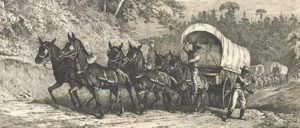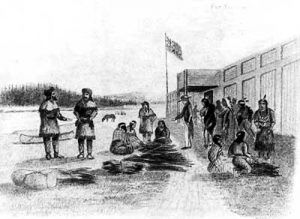Cantonment Wright (1861-1862) – Located near Milltown, Montana, this was the winter camp for Captain John Muller and his building crew, as they were building the Mullan Road which made its way from Fort Benton, Montana to Walla Walla, Washington.
Fort Browning (1868-1873) – This military post, located at the junction of Peoples Creek and the Milk River, was located two miles southwest of Dodson, Montana. Named for O.H. Browning, Secretary of the Interior, the fort served as the Indian Agency for the Assiniboine and Upper Sioux. It was abandoned in 1873 when the Assiniboine were moved to Fort Belknap and the Sioux to Fort Peck.
Fort Cass (1832-1835) – Also known as Tullochs Fort, the sub-post of Fort Union, North Dakota was established by Samuel Tulloch for the American Fur Company to trade with the Crow Indians. Named for Lewis Cass of Michigan, it was located three miles below the mouth of the Big Horn River on the east bank of the Yellowstone River. The fort was surrounded by cottonwood pickets with two bastions in the corners. In 1835 it was abandoned and replaced by Fort Van Buren. The site is located in Treasure County, Montana, but there are no remains.
Fort Conrad (1875-1878) – Built by Charles Conrad in 1875, it was located on the south bank of the Marias River above the mouth of the Dry Fork River about 80 miles Northwest of Fort Benton. Connecting log cabins formed three sides of a 150′ x 150′ square. The fort was bought by Joseph Kipp in 1878.
Fort Copelin (1865) – This stockade was built in 1865 to protect freight left at Milk River by steamboats. It was divided into three sections to house goods of freight owners.
Fort Cotton (1842) – Also called Fort Honore, this post was established by the Fox, Livingston & Company on the site which would later become Fort Lewis. It was named for a partner in the company. Located about 18 miles above Fort Benton, the post was short-lived.
Fort Dauphin (1860-1865) – A trading post established at the mouth of Milk River by Louis Dauphin, a Creole trapper. He was killed by Sioux near here in 1865.
Fort Fizzle (1877) – A temporary barricade about five miles above the mouth of Lolo Canyon. It was erected on July 25, 1877, by Captain C.C. Rawn in an attempt to halt the flight of the Nez Perce. It was nicknamed Fort Fizzle after the failure to stop the Indians.
Fort Fox & Livingston (1842-1844) – A trading post established in 1842 to compete with the American Fur Company by Fox, Livingston & Company. It was located approximately 11 miles below Fort Benton on the east bank at or near Shonkin Creek. It was moved in 1844 to the site of the first Fort Lewis. It was bought out by the American Fur Company in May 1845.
Fort Galpin (1862) – A trading post established in 1862 by Charles Larpentuer for the LaBarge, Harkness & Company. It was named for William and Charles Galpin who were partners in the company. It was located 12 miles above the mouth of the Milk River.
Fort Gilbert (1864-1867) – A trading post established at the edge of the Fort Buford, North Dakota Military Reservation, it was named for Colonel Charles Gilbert, a one-time commanding officer at Fort Buford. Located at the southern boundary of the military reservation on the west bank of the Yellowstone River, the post served the Yellowstone Valley. Though there is nothing left of the post today, a marker designates the site about five miles north of Sidney, Montana on state highway 200.
Fort Hawley (1866) – A trading post established by Louis Rivet of the North West Company, it was named for A.F. Hawley, a partner in the company. It was established to trade with the River Crow Indians. It was located below Fort Benton on the south side of the Missouri River about 20 miles above the Musselshell River.
Fort Henry (1822-1823) – Named for Andrew Henry, this post stood at the junction of the Missouri and Yellowstone Rivers. It was destroyed by Indians just a year after it was established.
Fort Howes (1897) – A rock-walled redoubt on a hill above the Howes Ranch south of Ashland. It was built as a civil defense against a threatened outbreak by the Cheyenne in 1897. It was comprised of 10′ x 18′ rock walls with a plank roof.
Fort Jackson (1833-1834) – A trading post established in December 1833 by Francis A. Chardon near the mouth of the Poplar River, it was named for Andrew Jackson. It was 50′ square structure. It was abandoned the very next year.
Fort LaBarge (1862-1863) – This post was established by John and Joseph LaBarge, famous river pilots, along with James Harkness, who formed the LaBarge, Harkness & Company to compete with the American Fur Company. It was located just upriver from old Fort Campbell. Unfortunately, LaBarge, Harkness & Company went bankrupt in 1863 when the river was unusually low and they were unable to deliver the goods they had contracted. It was later purchased by the American Fur Company.
Fort Lewis – In January 1845, Alexander Culbertson, an agent for the American Fur Company, established Fort Lewis on the Missouri River about 18 miles upstream from present-day Fort Benton to trade with the Blackfeet Indians. However, the tribe did not like the location, so a year later, Culbertson moved the post to a more accessible spot on the Missouri River. The log buildings were then dismantled and floated downstream to the new site. The new site also was called Fort Lewis, until it was changed to Fort Benton in 1860.
Fort Piegan (1831-1832) – This non-military fort was established in October, 1831 by James Kipp for the American Fur Company. Located by the mouth of the Marias River, it was the first successful trading post among the Blackfeet Indians. The fortress including three large log buildings surrounded by a 25 foot palisade. it was abandoned in 1832.
Fort Van Buren (1835-1842) – Established 1835 by Samuel Tulloch for the American Fur Company, it was named for President Martin Van Buren. Built on the right bank of the Yellowstone River near the mouth of the Tongue River, it operated for several years before Charles Larpenteur burned the post in 1842 before building Fort Alexander. It was thought to have been located near Rosebud, Montana.
Kootenai Post (1808-1811) – This trading post was established in 1908 for the North West Company near Libby, Montana. It was relocated upstream three years later, near Jennings.
Lewis and Clark Fort (1810) – Also referred to as Three Forks Post, this short-lived trading post was established in April 1810 by Andrew Henry and Pierre Menard. Guided to the Three Forks of the by John Colter, it was located between the Madison and Jefferson Rivers. The post was surrounded by a 200′ square stockade. It was abandoned in the fall of 1810 because of Indian harassment. The site was first mentioned as a possible site of a fort by Lewis and Clark in their journals.
Saleesh House (1809-1824) – Established in 1809 by David Thompson for the Northwest Company, this trading post was located two miles east of Thompson Falls, on the Clark Fork River just below its junction with the Thompson River. In 1824 it was moved to a site near Eddy, Montana, was renamed Flathead Post, and was operated by James McMillan and Ross Cox.
By Kathy Alexander/Legends of America, updated February 2022.
Also See:


